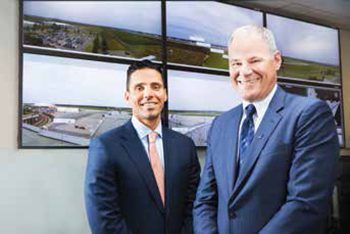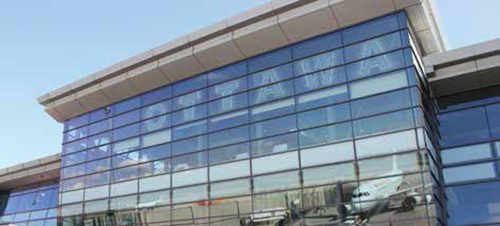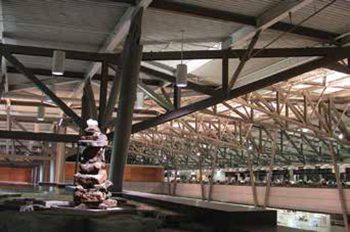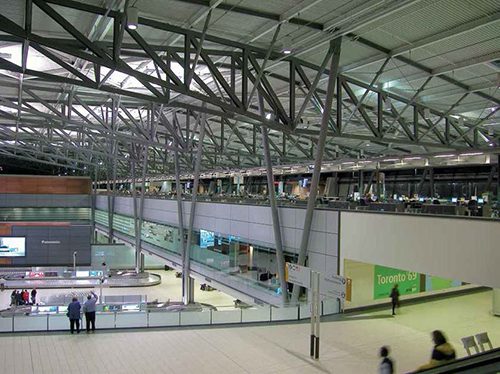Collaboration and ongoing improvement are guiding principles at Ottawa Macdonald-Cartier International (YOW). Recent enhancements to the airport’s high-tech operations control center demonstrate how important both are at the Ontario facility.
After redesigning and restructuring YOW’s Airport Operations Control Centre, the Ottawa International Airport Authority partnered with Searidge Technologies last year to further improve situational awareness and response capabilities. Officials from both organizations describe the relationship as a win/win situation: The airport benefits from new technology and all the efficiencies it provides; Searidge gains a local beta site for research and development.
| FACTS&FIGURES Project: Airport Operations Control Center Location: Ottawa Macdonald-Cartier Int’l Airport Provider: Searidge Technologies Components: Info is combined from various data sources including flight info display systems, airport operations database, security cameras, alarm/security systems; air traffic control; etc. Key Benefits: Increased operating control/efficiency; improved situational awareness; safety & security enhancements Of Note: Airport serves as research & development site for NAV CANADA/Searidge |
In essence, YOW added an adjunct member to its existing continual improvement team. For its part, Searidge pulls information from various data sources and integrates it into a single, customized interface for airport personnel. Data sources include YOW’s flight information display system, the airport operations database, a closed-circuit television network, alarm/security equipment and air traffic management/air traffic control data.
“Searidge is working with us to integrate all of our airport information sources-real-time surface management data, air traffic control data and airport-centric data-into a single application, which will ultimately make our airport more efficient than ever,” says Mark Laroche, YOW’s chief executive officer.
In addition to working directly with YOW, Searidge provides remote tower and surface optimization technologies to air navigation service providers and airports throughout the industry. Since 2010, the majority interest of the company has been held by NAV CANADA, the private, non-profit entity that provides the country’s civil air navigation services. While Searidge continues to operate independently, it gained access to a wider set of tools and operational capabilities, as NAV CANADA is the world’s second-largest air navigation service provider by traffic volume. Each year it manages 12 million aircraft movements for 40,000 customers over 18 million square kilometers.
“Now, we can pull real-time information from NAV CANADA, like surveillance and weather data. And when we install new technology at the airport, we can bring NAV CANADA and the authority together to streamline operations,” explains Searidge Chief Executive Officer Moodie Cheikh. “We can pursue creative ideas that have the potential to change the aviation industry.”
Home-Team Advantage
Searidge’s location in Ottawa figured prominently when YOW officials first considered the partnership, notes Laroche: “Because Searidge is in our backyard, it gave us a reason to take a look at them and get to know them. Economically, they play a role in the community, and that is important to us. We didn’t have an immediate need for all of the features they have to offer, but we plan to grow with it. It’s a mutually-beneficial partnership that is appreciated from both sides.”
 Over the years, airport officials kept tabs on Searidge, and the partnership eventually evolved organically, Laroche relates.
Over the years, airport officials kept tabs on Searidge, and the partnership eventually evolved organically, Laroche relates.
Cheikh reflects on the early days, in 2006, when the two organizations began working together. Searidge was much smaller back then and readily played the “Ottawa card” when asking YOW for permission to install cameras and other equipment at the airport for testing purposes. “Technology was nowhere near where it is today, and video wasn’t even used back then to move airplanes,” he recalls. YOW agreed to help the expanding local company, and Searidge engineers set up test equipment. “For about a year we collected the info we needed and it helped us tremendously with product development,” Cheikh reflects.
These days, YOW operates nearly every product Searidge markets. “It was and is an iterative approach to find out what could make it better, and then we do it again,” he says. “By the third iteration, we often have something the customer finds very valuable.”
Increasing Efficiencies
YOW’s new system converts the video captured by equipment Searidge installed on the ramp and converts it into track data, which allows airport personnel to see where individual aircraft are on the airport’s surface areas.
 “Instead of presenting a video screen, we could present them with a top-down, 2D map view, which is what they were used to seeing,” explains Cheikh. “What we needed to do was install the cameras on the ramp to record movements of aircraft and vehicles. The output was a top-down map view of all of the traffic; essentially, we digitized video and turned it into data. Then we could automatically tell the airport when an aircraft was on blocks, or if there was a vehicle behind the aircraft.”
“Instead of presenting a video screen, we could present them with a top-down, 2D map view, which is what they were used to seeing,” explains Cheikh. “What we needed to do was install the cameras on the ramp to record movements of aircraft and vehicles. The output was a top-down map view of all of the traffic; essentially, we digitized video and turned it into data. Then we could automatically tell the airport when an aircraft was on blocks, or if there was a vehicle behind the aircraft.”
The partnership between Searidge and YOW is currently entering its second phase, and project planners have identified several specific internal and external data sources that feed into the airport operations control center.
Some of YOW’s existing resources-hundreds of video cameras, for instance-will play a primary role. “We asked ourselves what we could do to leverage that investment,” explains Cheikh. “If we take information from those security cameras and bring the capability to the airport’s operations team, can that enhance the way they do their jobs?”
 Incorporating video from YOW’s security system with other existing data is just one example of how the airport and Searidge hope to capitalize on the power of integration. At a glance, operations personnel can monitor activity on the airfield in context with what other data feeds tell them should be happening. The integrated, multi-source information stream is designed to make it easier for them to manage from a distance, Cheikh explains. During emergency situations, for example, they are able to dispatch vehicles more quickly. Laroche calls the new system a “window” on YOW’s airfield.
Incorporating video from YOW’s security system with other existing data is just one example of how the airport and Searidge hope to capitalize on the power of integration. At a glance, operations personnel can monitor activity on the airfield in context with what other data feeds tell them should be happening. The integrated, multi-source information stream is designed to make it easier for them to manage from a distance, Cheikh explains. During emergency situations, for example, they are able to dispatch vehicles more quickly. Laroche calls the new system a “window” on YOW’s airfield.
“As we started collecting more data, we could see more about what’s going on with the airfield and we can zoom in and point and click on the display,” he relates. “It provides situational awareness and gives us better operational control.”
Over the past year, YOW integrated its asset tracking incursion management system into the new operating control center system. Now, vehicles owned by the airport authority that are fitted with tracking devices can be monitored in the airport operations control center. In addition to improving general traffic control, the new capability facilitates more efficient decision-making about the dispatch of airside vehicles, notes Laroche.
Data feeds from air traffic control and airport systems are integrated with the Searidge platform to provide the airport’s flight information display system with more accurate arrival times for passengers. Such data is also expected to enhance YOW’s gate assignment and apron management processes.
“The more information we can have on a single display, the easier it is for managers to get a quick sense of what’s going on and make operational decisions, such as snow clearing operations,” says Laroche. “That takes a lot of information and analysis. It’s all about having more efficient, safe and secure operations on the airfield. And, as we are able to dedicate more resources-which we should be able to as we realize the efficiencies that are inherent in the system-we will expand our implementation.”
Given the operational improvements the airport has already experienced, Laroche says he would like to see other operational systems integrated into the operations control center. Currently, Searidge and YOW are testing an intrusion detection system for possible inclusion. Another goal is to develop a heads-up display with data such as notices to airmen, real-time weather, wind direction and runway friction information.
“I agree with the many advantages that such a strategic partnership will have for the airport, which include enhanced airfield operations management, enhanced security and enhanced safety,” Laroche reflects. “Furthermore, this will provide the Ottawa Airport with increased use of technology and keep us at the forefront of video and data integration usage in our new AOCC (airport operations control center). By partnering with a local company, we are also contributing to economic development and will benefit from future development of airport management systems.”
Safety First
Cheikh acknowledges that implementing new processes and technologies can be challenging for airports. “Aviation is a risk-averse industry, as it should be,” he remarks. “Typically, efficiency is priority number two, after safety.”
With air traffic increasing and most airports lacking the physical space to add runways and other airfield infrastructure, Cheikh believes that technology is the only way for many facilities to expand. “I want the industry to understand that status quo is not an option,” he emphasizes.
The Searidge exec also stresses that introducing new systems into safety-critical operations is a complicated and delicate process, and considers it his company’s role to help airports deploy technology in a way that will enable safer and more efficient operations.
On a similar and complementary note, Laroche stresses YOW’s part in the process: “Our mission is to be a leader in providing safe, secure air transportation services and to drive economic prosperity in our community. In our business, we are all risk averse in terms of safety and security; we want to do everything we can to mitigate risk and look at every opportunity. On the other hand, we [at YOW] are early adopters of technologies such as common-use and virtualization, and we’re constantly pushing the envelope to find creative ways of doing more with less.”
The partnership between YOW and Searidge has allowed the airport to invest its time and resources on its own schedule and gives officials alternate means of accomplishing operations goals, adds Cheikh. “By making that investment now, they’ll be able to grow when they need it,” he notes.
Laroche predicts that the partnership, and the technology it brings to the airfield, will continue to evolve as the airport’s needs evolve. Currently, YOW is planning to install additional security measures on the apron and critical area zones, and eventually plans to add an intrusion detection system. The plan is to link an alarm to the existing interface so staff in the airport operations control center have to watch only one master screen.
Due to the operations control center’s recent debut and the ongoing nature of its development, airport officials say it would be premature to discuss specific cost/benefit details. “It’s difficult to assign a return on the investment in real dollars,” says Laroche, noting that the airport looks forward to planning future refinement projects with Searidge. “We have not seen the full limits yet. There are many more applications we haven’t even considered.”



